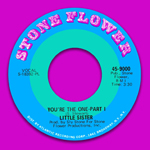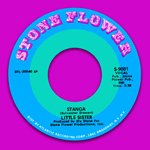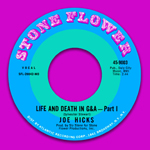
Although 1970 would wind up being an unproductive year for Sly & The Family Stone, the same could not be claimed for Sly as his “Written by Sylvester Stewart/Produced and arranged by Sly Stone” credit would appear on six singles that year. First was the 2-sided “I’m Goin’ Home” by Joe Hicks on Scepter followed by “Life And Death In G&A” (the A-side a project for A&M Records credited to Abaco Dream with Hicks as vocalist with backing from The Family Stone) and then a series of singles released on Stone Flower, a subsidiary label of Atlantic Records set up by Sly’s manager David Kapralik to allow for projects outside of the Family Stone under Sly’s guiding hand and direction. Although only yielding four singles before the label folded in 1971, they illustrate a significant point in Sly’s career that otherwise would have passed entirely undocumented. Heralding his recently acquired Maestro Rhythm King drum machine used in conjunction with wah-wah’d daubs of electric organ in low-key tempos relaxed to the point of catatonia, they exhibited a major root treatment he would continue to pursue into the following year all over Sly & The Family Stone’s none-too-forthcoming album -- provisionally entitled “The Unpredictable And Incredible Sly & The Family Stone” then “Africa Talks To You” before its final realisation as “There’s A Riot Goin’ On.”
 The first single on Stone Flower was by the vocal group Little Sister comprised of Mary McCreary, Elva Mouton and fronted by Sly’s youngest sister, Vaetta Stewart. Released in February of 1970, “I’m The One (Part 1)”/ “I’m The One (Part 2)” climbed to #22 in the charts and would be the most commercially successful of the Stone Flower catalogue. Upbeat and movin’ on up in both the lyrics and arrangement, it featured segments scored with horns, poppin’ bass a-plenty and must have been a big discotheque mover at the time of its release -- a good three years before the advent of wholesale waka jawaka conventions (“I’m The One” would also be included in Sly & The Family Stone’s live set, with Little Sister absorbed full-time into the group on their series of 1973 live dates.) “I’m The One” and the other three Stone Flower singles all prove Sly’s position as an avant-garde artist working from the confines of a no-man’s/all-dude’s twilight zone twixt white pop and black dance music; creating sounds ahead of the curve with constantly hurled curveballs from left field that were oddball, eight ball, in the pocket, fantastic to move to or and just too interesting to ignore...
The first single on Stone Flower was by the vocal group Little Sister comprised of Mary McCreary, Elva Mouton and fronted by Sly’s youngest sister, Vaetta Stewart. Released in February of 1970, “I’m The One (Part 1)”/ “I’m The One (Part 2)” climbed to #22 in the charts and would be the most commercially successful of the Stone Flower catalogue. Upbeat and movin’ on up in both the lyrics and arrangement, it featured segments scored with horns, poppin’ bass a-plenty and must have been a big discotheque mover at the time of its release -- a good three years before the advent of wholesale waka jawaka conventions (“I’m The One” would also be included in Sly & The Family Stone’s live set, with Little Sister absorbed full-time into the group on their series of 1973 live dates.) “I’m The One” and the other three Stone Flower singles all prove Sly’s position as an avant-garde artist working from the confines of a no-man’s/all-dude’s twilight zone twixt white pop and black dance music; creating sounds ahead of the curve with constantly hurled curveballs from left field that were oddball, eight ball, in the pocket, fantastic to move to or and just too interesting to ignore... As was the case with the second Little Sister single, “Stanga” backed with a cover of The Family Stone’s “Somebody’s Watching You.” As was the case with the remaining two Stone Flower releases, its unorthodox sound and arrangement featured percussion not from a drum kit but prominent drum machine patterning with accompanying percolating bass playing from Big Brother Syl. “Stanga” is a low pressure system moving at the speed of a single stream squeaking out from a single, tiny fissure in a levee harnessing an ocean of beats. Undulating waves of wah-wah’d electric organ or heavily-treated clavinet filter through from the depths of its barely furnished domain. Sly’s spindly and almost noncommittal wah-wah guitar lurches in place behind the clear blending harmonies of Little Sister while his overdubbed bass lines have unrestricted access to bubble against the unshakably metronome-solid drum machine pattern. Sly casually waves his hand over the keyboard in flourish just before it decides to ebb off into silence.
As was the case with the second Little Sister single, “Stanga” backed with a cover of The Family Stone’s “Somebody’s Watching You.” As was the case with the remaining two Stone Flower releases, its unorthodox sound and arrangement featured percussion not from a drum kit but prominent drum machine patterning with accompanying percolating bass playing from Big Brother Syl. “Stanga” is a low pressure system moving at the speed of a single stream squeaking out from a single, tiny fissure in a levee harnessing an ocean of beats. Undulating waves of wah-wah’d electric organ or heavily-treated clavinet filter through from the depths of its barely furnished domain. Sly’s spindly and almost noncommittal wah-wah guitar lurches in place behind the clear blending harmonies of Little Sister while his overdubbed bass lines have unrestricted access to bubble against the unshakably metronome-solid drum machine pattern. Sly casually waves his hand over the keyboard in flourish just before it decides to ebb off into silence.
“Somebody’s Watching You” holds a treatment more befitting of the lyric’s oblique mood than The Family Stone original from the previous year as a shuffling drum machine pattern drowned out by Sly’s zig-zagging free-bass plucking afford a relaxed environment for the beautifully blending vocalising issuing forth from the smooth throats of Vaetta, Mary and Elva. Despite its title, “Somebody’s Watching You” deals not with issues of paranoia as much as the realisation of deep truths rising to the surface as clusters of unresolved thoughts begin to consolidate in the seat of conscience of its author. “The higher the price/The nicer the nice” sing Little Sister as three little angels perched on one shoulder of Sylvester Stewart with the weight of the Stone One on the other.
 The third Stone Flower single took a step further down into even more restrictive funk territory with the sole release by 6IX, “Dynamite”/“I’m Just Like You.” 6IX were a four piece vocal group comprised of Charles Higgins (lead vocals), Marvin Braxton (backing vocals, harmonica), Gil Bottliglere (backing vocals) and Paul Stallwell (backing vocals) while Sly handled the musical backing on organ, guitar, bass and drum machine. Super slowed to the paces of a hollowed-out, electronic skank on half a tank and steeped in molasses, “Dynamite” barges in immediately with a blaring, wah-wah’d rhythm guitar from Sly over the opening vocal chorus of his young 6IX cohorts. Two years on from operating as the starter for Sly & The Family Stone’s “Life” album, “Dynamite” is here reduced to narcotised bare bones in a near-reggae velocity with the most minimal of instrumentation. If the Maestro Rhythm King had a setting called ‘Broken Windscreen Wiper Bossa Nova’ then it was used here. The flipside “I’m Just like You” is nothing like the A-side as it’s been cleared of all clutter except for Charles Higgins’ vocals laid out over an anesthetising drum machine rhythm that simmers like a pan of ‘Ricky Retardo Samba’ kept on the edge perpetual boil.
The third Stone Flower single took a step further down into even more restrictive funk territory with the sole release by 6IX, “Dynamite”/“I’m Just Like You.” 6IX were a four piece vocal group comprised of Charles Higgins (lead vocals), Marvin Braxton (backing vocals, harmonica), Gil Bottliglere (backing vocals) and Paul Stallwell (backing vocals) while Sly handled the musical backing on organ, guitar, bass and drum machine. Super slowed to the paces of a hollowed-out, electronic skank on half a tank and steeped in molasses, “Dynamite” barges in immediately with a blaring, wah-wah’d rhythm guitar from Sly over the opening vocal chorus of his young 6IX cohorts. Two years on from operating as the starter for Sly & The Family Stone’s “Life” album, “Dynamite” is here reduced to narcotised bare bones in a near-reggae velocity with the most minimal of instrumentation. If the Maestro Rhythm King had a setting called ‘Broken Windscreen Wiper Bossa Nova’ then it was used here. The flipside “I’m Just like You” is nothing like the A-side as it’s been cleared of all clutter except for Charles Higgins’ vocals laid out over an anesthetising drum machine rhythm that simmers like a pan of ‘Ricky Retardo Samba’ kept on the edge perpetual boil.

The final Stone Flower 45 would be Joe Hicks’ “Life And Death In G&A.” Spread out as a seven minute, two-part funk dirge over both sides, it is the furthest cry imaginable from its previous Family Stone-styled arrangement (under the alias of Abaco Dream) of charged brass constructions, harmony vocals and tight drumming. Here, Sly and Hicks have burrowed so deeply in groove that there is nothing left but a tiny and oppressive pulsation of the densest kind. It’s inconceivable that in 1970, Epic Records would’ve even accepted this as a demo. Punctuated only by lightning forks of echoed, searing wah-wah’d Farfisa organ and lyrics that drift horizontally by, “Life And Death In G&A” trudges on like death reanimated only by those stabs of abrupt e-organ wah-wah’d to constant burbling while the drum machine chugs at a top speed of a fractured handful beats per second matched in tardiness only. Over Hicks’ desperately straining vocals, Sly drops in overamped bass clusters everywhere as slight guitar accents and electric organ wah-wah notes dart in and out without warning. A perfect illustration of Sly’s use of contrasting opposites in his lyrics as counterpoint to the unchanging rhythmic backing track he constructed by himself, “Life And Death In G&A” sees Sly’s ping-ponging rumination on opposites at its highest degree. For outside the contrasting laundry list of opposites that begin with “Good and the bad/Big and the small/In and out/None and all” and ends with “river’s deep/mountain’s high” hangs the larger counterbalance of regimented, machine-generated rhythms Sly created to bounce off of with undercurrents of nuanced bass lines, near-haphazard guitar riffs and staggered keyboard accenting that coexist within the strictest confines of pre-determined clockwork grooves. In a 1978 interview, Brian Eno put forth the interesting suggestion that someone get Kraftwerk and Parliament and “put those two together and say, ‘Make a record.’” But Sly had already come as close to fulfilling that partnering as anyone AND a full eight years earlier. Although Ralf and Florian did claim a Maestro Rhythm King drum machine as part of their Kling Klang arsenal by 1971, Sly had already achieved with his Stone Flower output possibly the smallest and earliest sub-genre of electro-funk, ever. ‘Why’ is the question, and perhaps the beseechingly sung chorus by Joe Hicks is the answer: “If it feels good, it’s alright...”
Note: Little Sister’s “Stanga” and 6IX’s “I’m Just like You” are currently available on CD, appearing on the recent “What It Is!” funk box set with a slightly-differently mixed version of “I’m Just Like You” surfacing on the “Funk Drops 3” compilation. A definitive gathering of these sides into an anthology is puzzling -- not to mention long overdue.

Little Sister – “I’m The One (Part 1)” / “I’m The One (Part 2)”

Little Sister – “Stanga” / “Somebody’s Watching You”
“Somebody’s Watching You” holds a treatment more befitting of the lyric’s oblique mood than The Family Stone original from the previous year as a shuffling drum machine pattern drowned out by Sly’s zig-zagging free-bass plucking afford a relaxed environment for the beautifully blending vocalising issuing forth from the smooth throats of Vaetta, Mary and Elva. Despite its title, “Somebody’s Watching You” deals not with issues of paranoia as much as the realisation of deep truths rising to the surface as clusters of unresolved thoughts begin to consolidate in the seat of conscience of its author. “The higher the price/The nicer the nice” sing Little Sister as three little angels perched on one shoulder of Sylvester Stewart with the weight of the Stone One on the other.

6IX – “Dynamite” / “I’m Just Like You”

Joe Hicks – “Life And Death In G&A”
Note: Little Sister’s “Stanga” and 6IX’s “I’m Just like You” are currently available on CD, appearing on the recent “What It Is!” funk box set with a slightly-differently mixed version of “I’m Just Like You” surfacing on the “Funk Drops 3” compilation. A definitive gathering of these sides into an anthology is puzzling -- not to mention long overdue.

 Li Jianhong
Li Jianhong The Routes
The Routes Chairmen Of The Board
Chairmen Of The Board Evil Acidhead
Evil Acidhead Henry Wolff & Nancy Hennings
Henry Wolff & Nancy Hennings Silver Apples
Silver Apples Silver Apples
Silver Apples Ernest Gibson
Ernest Gibson DETROITROCK SAMPLER
DETROITROCK SAMPLER HARDROCK SAMPLER
HARDROCK SAMPLER Early Soft Machine (1966-68)
Early Soft Machine (1966-68) 5-Track
5-Track